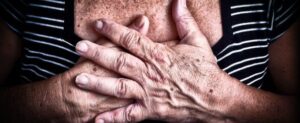Today, Straight, No Chaser will present two phrases that you may not have previously heard: The Great Mimicker and MSM, and that means we’re discussing what has historically been a devastating disease: syphilis. Historically, syphilis really is the most important sexually transmitted disease (For what it’s worth, it’s thought that Columbus’ crew spread the disease between the Americas and Europe.). The great mimicker nickname as applied to syphilis exists because syphilis has many general symptoms that resemble and are often confused with other diseases. MSM points to the fact that treatment in the early stages is so complete that syphilis had been rapidly in decline – until it’s reemergence in a specific population. It is estimated that well over 60% of reported early stage cases of syphilis occurs in men who have sex with men (MSM).
In this review, I want to specifically address the symptoms, which are impressively and dramatically different depending on the stage.

Stage I – Primary Syphilis: Primary syphilis usually presents with the presence of a single, painless sore (a chancre), located wherever it was contracted. As pictured above, the head (glans) of the penis is a typical site. The sore disappears in 3-6 weeks (with or without treatment), and if treatment wasn’t received, the disease progresses. Herein lies the problems. Because it’s painless, you ignore it, perhaps thinking it was a friction sore, or you never gave it much of a thought. Because it went away on its own, you forget about it, thinking that it got better. So sad, so wrong…


Stage II – Secondary Syphilis: When syphilis returns days to weeks (more typically) after the primary infection, it does so quite dramatically. Rashes can appear everywhere, including across your back (as noted above) and chest to on your palms and soles, in your mouth, groin, vagina, anus, or armpits. The rash could be warts (condyloma lata) or flat. You should be scared, but you might not be because… the rash and the other symptoms again will disappear on its own. Despite what you may think intuitively, you really don’t want that to happen.
Latent Syphilis: Dormant syphilis can stay that way for decades after secondary syphilis has occurred. What you don’t know can hurt you. Syphilis can be transmitted during the earlier portion of latent phases, including to an unborn child.

Tertiary Syphilis: Late stage syphilis is a disturbing thing to see (and obviously experience). The disease can result in death, causing damage to the brain, heart, liver, bones, joints, eyes, the nervous system and blood vessels. Before it kills you, it can result in blindness, paralysis, dementia and loss of motor control. If you don’t know how the research discovering all of this was conducted, for now I’ll just say it was one of the most shameful acts of medical history. I’ll blog on it later. The individuals in the above picture were alive when these pictures were taken, by the way.
A special note: The microorganism causing syphilis is rather aggressive, so much so that it can be transmitted by oral, anal or genital sexual contact. By oral, I also mean kissing. Pay attention to those oral sores. Furthermore, syphilis gets transmitted from mother to unborn child. This is a devastating occurrence – if untreated, a child may be born prematurely, with low birth weight or even stillborn. If untreated, once born, a child may suffer deafness, seizures and cataracts before death.
Prevention and Treatment Considerations: Advanced syphilis is especially disheartening because it is so easily treated and prevented. Prevention is as simple as always wearing condoms, being in a monogamous relationship with someone confirmed not to have it, checking your sexual partner prior to sex and not engaging in sex if any type of sore/ulcer is in the mouth, genitalia or anal region. Regarding treatment, syphilis once upon a time was quite the plague until penicillin was discovered; treating syphilis is how penicillin ‘made a name’ for itself. Treatment with penicillin easily kills syphilis but unfortunately does nothing for damage that has already occurred. Remember that treating syphilis at any point can prevent the most severe complications that lead to death.
Feel free to ask your SMA expert consultant any questions you may have on this topic.
Take the #72HoursChallenge, and join the community. As a thank you for being a valued subscriber to Straight, No Chaser, we’d like to offer you a complimentary 30-day membership at www.72hourslife.com. Just use the code #NoChaser, and yes, it’s ok if you share!
Order your copy of Dr. Sterling’s new books There are 72 Hours in a Day: Using Efficiency to Better Enjoy Every Part of Your Life and The 72 Hours in a Day Workbook: The Journey to The 72 Hours Life in 72 Days at Amazon or at www.72hourslife.com. Receive introductory pricing with orders!
Thanks for liking and following Straight, No Chaser! This public service provides a sample of what http://www.SterlingMedicalAdvice.com (SMA) and 844-SMA-TALK offers. Please share our page with your friends on WordPress, like us on Facebook @ SterlingMedicalAdvice.com and follow us on Twitter at @asksterlingmd.
Copyright © 2018 · Sterling Initiatives, LLC · Powered by WordPress























